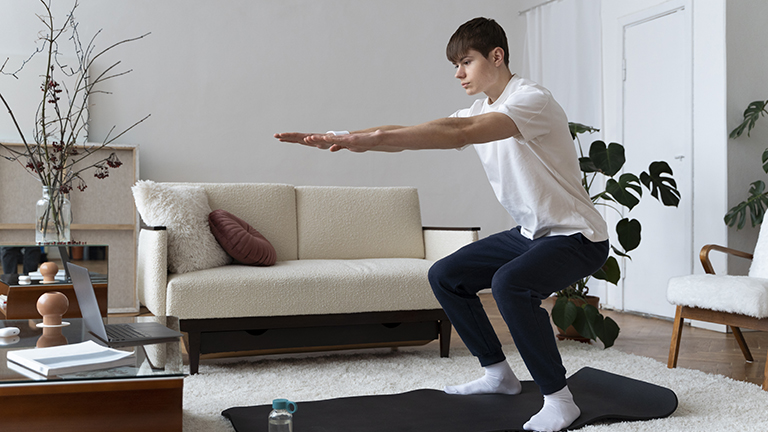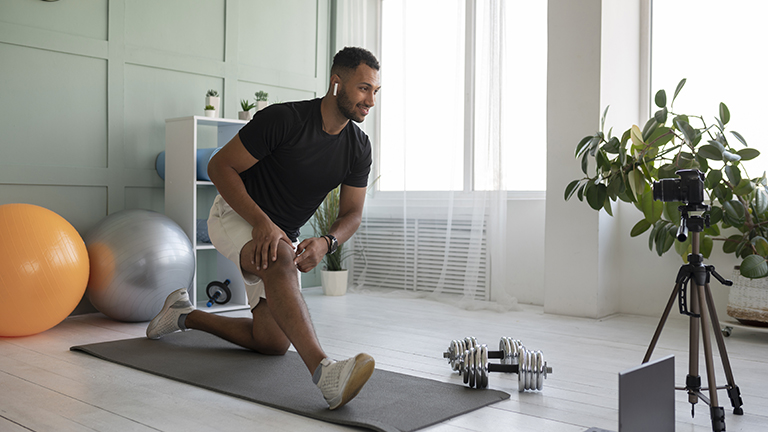Exercises for Prostate Health at Home: Prostate health is a crucial aspect of men’s overall well-being, yet it is often overlooked until problems arise. The prostate, a small gland located just below the bladder, plays a vital role in male reproductive and urinary systems. As men age, the risk of prostate-related issues, such as benign prostatic hyperplasia (BPH), prostatitis, and prostate cancer, increases significantly. These conditions can cause uncomfortable symptoms, including frequent urination, weak urinary flow, pelvic pain, and sexual health concerns, affecting daily life and quality of living.
Fortunately, maintaining a healthy prostate is possible through proactive lifestyle choices. Among these, regular exercise emerges as one of the most effective and accessible strategies. Incorporating the best exercises for prostate health at home not only strengthens the pelvic floor and improves urinary control but also supports overall physical fitness, hormonal balance, and cardiovascular health. Unlike medications or invasive treatments, home exercises offer a natural, cost-effective, and safe approach that can be easily adapted to daily routines.
In addition to physical activity, combining exercise with a balanced diet, proper hydration, and stress management can significantly reduce the risk of prostate complications. Exercises such as Kegels, squats, lunges, pelvic tilts, yoga, and aerobic routines are specifically beneficial in promoting prostate function and enhancing quality of life. The convenience of performing these exercises at home makes it easier for men of all ages to commit to a consistent routine, achieving long-term health benefits.
Understanding Prostate Health
What is the Prostate and Its Function?
The prostate is a small, walnut-shaped gland located just below the bladder and in front of the rectum. Its primary function is to produce seminal fluid, which nourishes and transports sperm during ejaculation. Though small in size, the prostate has a significant impact on urinary and sexual health.
The gland’s health can be influenced by age, lifestyle, genetics, and diet. As men grow older, the prostate may enlarge—a condition known as benign prostatic hyperplasia (BPH). Symptoms of prostate issues often include frequent urination, difficulty urinating, weak urinary flow, and pelvic discomfort.
[INSERT_ELEMENTOR id=”5108″]
Common Prostate Problems and Symptoms
Several conditions can affect the prostate:
- Benign Prostatic Hyperplasia (BPH): Non-cancerous enlargement of the prostate, causing urinary difficulties.
- Prostatitis: Inflammation of the prostate due to infection or chronic conditions.
- Prostate Cancer: A serious condition affecting millions of men worldwide.
Early detection and preventive measures, including exercise, can significantly reduce the risk and improve overall prostate function.
Why Exercise is Important for Prostate Health
How Physical Activity Helps Reduce Risk
Research indicates that regular exercise can play a critical role in maintaining prostate health. Physical activity improves blood circulation, supports hormonal balance, reduces inflammation, and helps maintain a healthy weight. Excess weight and sedentary lifestyles are linked to increased prostate-related complications.
Benefits of At-Home Workouts
Home exercises are convenient and accessible, allowing men to maintain a consistent routine without gym membership or specialized equipment. At-home workouts can improve urinary control, strengthen pelvic muscles, reduce stress, and support overall cardiovascular health, all of which contribute to a healthier prostate.
Best Exercises for Prostate Health at Home
Kegel Exercises for Men
Kegel exercises are specifically designed to strengthen the pelvic floor muscles, which support the bladder, prostate, and rectum. Strong pelvic muscles can improve urinary control, enhance sexual health, and reduce discomfort associated with an enlarged prostate.
To perform Kegels:
- Identify the pelvic muscles by stopping urination midstream.
- Contract these muscles for 5-10 seconds, then relax.
- Repeat 10-15 times per session, aiming for 3 sessions daily.
Consistency is key, and these exercises can be performed discreetly anytime, anywhere.
Squats and Lunges
Squats and lunges are excellent for strengthening lower body muscles and improving pelvic blood flow, which supports prostate function. These exercises also enhance hormonal balance and cardiovascular health, both essential for prostate wellness.
To perform a squat:
- Stand with feet shoulder-width apart.
- Lower your hips as if sitting in a chair, keeping knees behind toes.
- Rise back to standing.
For lunges:
- Step forward with one leg, lowering your hips until both knees are bent at 90 degrees.
- Push back to the starting position and repeat with the opposite leg.
Perform 3 sets of 10-15 repetitions daily.
Pelvic Tilts
Pelvic tilts improve flexibility, strengthen abdominal and pelvic muscles, and reduce lower back strain. Strong pelvic muscles enhance bladder control and support overall prostate health.
To perform pelvic tilts:
- Lie on your back with knees bent and feet flat on the floor.
- Flatten your lower back against the floor by tightening your abdominal muscles.
- Hold for 5 seconds, then relax.
- Repeat 10-15 times per session.
Yoga Poses for Prostate Health
Certain yoga poses enhance circulation to the pelvic region, reduce stress, and strengthen core muscles. Key poses include:
- Bridge Pose: Supports lower back and pelvic floor muscles.
- Child’s Pose: Relieves pelvic tension and improves blood flow.
- Cat-Cow Stretch: Enhances spinal flexibility and pelvic mobility.
Practicing yoga 15-30 minutes daily can complement other exercises and improve overall prostate health.
Aerobic Exercises at Home
Aerobic exercises improve cardiovascular health, regulate weight, and reduce inflammation, all of which are beneficial for prostate function. Home-friendly aerobic options include:
- Brisk walking indoors or on a treadmill
- Jogging in place
- Jumping jacks or low-impact cardio routines
- Dance-based workouts
Aim for at least 150 minutes of moderate aerobic activity per week for optimal prostate benefits.
Best 5 Exercises for Prostate Health:
| Exercise | Purpose | How to Perform | Repetitions / Duration | Benefits for Prostate Health |
| Kegel Exercises | Strengthen pelvic floor muscles | Contract pelvic muscles as if stopping urine, hold 5–10 sec, relax | 10–15 reps, 3 sessions daily | Improves urinary control, reduces pelvic discomfort, supports sexual health |
| Squats | Strengthen lower body and improve circulation | Stand shoulder-width apart, lower hips as if sitting, rise back | 3 sets of 10–15 reps | Enhances blood flow to pelvic region, reduces inflammation, supports hormone balance |
| Lunges | Strengthen pelvic and leg muscles | Step forward, bend knees at 90°, push back, repeat with opposite leg | 3 sets of 10–12 reps per leg | Improves balance, flexibility, and pelvic blood circulation |
| Pelvic Tilts | Strengthen lower abs and pelvic muscles | Lie on back, knees bent, flatten lower back by tightening abs, hold, relax | 10–15 reps | Supports bladder control, reduces lower back strain, improves pelvic strength |
| Yoga Poses | Enhance flexibility, circulation, and core | Bridge Pose, Child’s Pose, Cat-Cow Stretch, hold each pose | 15–30 minutes daily | Reduces pelvic tension, improves blood flow, enhances core and prostate function |
Daily/Weekly At-Home Prostate Exercise Plan
Maintaining a consistent exercise routine is key to improving prostate health naturally. This 4-week plan combines pelvic floor exercises, strength training, and flexibility workouts, ensuring men of all ages can safely strengthen their prostate from home.
Daily Routine (Monday to Sunday)
Morning Session (10–15 minutes)
- Kegel Exercises: 10–15 repetitions, hold 5–10 seconds, 3 sessions
- Pelvic Tilts: 10–15 repetitions
- Optional: Light stretching or a short walk to boost circulation
Afternoon Session (15–20 minutes)
- Squats: 3 sets of 10–15 repetitions
- Lunges: 3 sets of 10–12 repetitions per leg
- Optional: Add a 5-minute brisk walk or low-impact cardio for extra benefit
Evening Session (15–30 minutes)
- Yoga Poses: Bridge Pose, Child’s Pose, Cat-Cow Stretch
- Focus on deep breathing to reduce stress and enhance pelvic circulation
Weekly Breakdown
| Day | Morning | Afternoon | Evening | Notes |
| Monday | Kegels + Pelvic Tilts | Squats + Lunges | Yoga | Focus on proper form, no rush |
| Tuesday | Kegels + Pelvic Tilts | Squats + Lunges | Yoga | Gradually increase repetitions if comfortable |
| Wednesday | Kegels + Pelvic Tilts | Squats + Lunges | Yoga | Include 5–10 min brisk walk |
| Thursday | Kegels + Pelvic Tilts | Squats + Lunges | Yoga | Focus on controlled breathing during exercises |
| Friday | Kegels + Pelvic Tilts | Squats + Lunges | Yoga | Optional: Add resistance band for squats/lunges |
| Saturday | Kegels + Pelvic Tilts | Squats + Lunges | Yoga | Take 1–2 min rest between sets |
| Sunday | Kegels + Pelvic Tilts | Light cardio or rest | Yoga | Active recovery day, light stretching |
Tips for Success
- Stay Consistent: Daily practice of Kegels and pelvic tilts ensures the pelvic floor muscles remain strong.
- Progress Gradually: Increase repetitions or duration slowly to avoid strain.
- Combine with Diet: Eat prostate-friendly foods like tomatoes, broccoli, nuts, and fatty fish to complement exercises.
- Hydration: Drink plenty of water to support urinary health and circulation.
- Mindful Practice: Focus on posture, breathing, and controlled movements during each exercise.
Following this daily and weekly routine for at least four weeks can improve urinary function, reduce pelvic discomfort, and enhance overall prostate health. Long-term commitment will help maintain prostate wellness, prevent enlargement, and support male sexual health naturally.
Creating a Daily Prostate Health Routine
How Often to Exercise
Consistency is essential for long-term benefits. Men should aim to perform pelvic floor exercises daily, incorporate strength training 3-4 times per week, and include aerobic activity most days. Over time, this combination supports hormonal balance, improves urinary function, and maintains prostate health.
Combining Exercises for Maximum Benefit
A balanced routine may include:
- Morning Kegels and pelvic tilts
- Afternoon squats or lunges
- Evening yoga session for relaxation and circulation
This combination ensures that muscles remain strong, flexible, and well-circulated, optimising prostate function.
Tips for Staying Consistent
- Set daily reminders
- Track progress in a journal
- Include a workout buddy or virtual class
- Gradually increase intensity to avoid injury
Lifestyle and Diet Tips for Prostate Health
Foods That Promote Prostate Health
Nutrition plays a vital role in reducing inflammation and supporting prostate function. Recommended foods include:
- Tomatoes and tomato-based products rich in lycopene
- Cruciferous vegetables like broccoli and cauliflower
- Fatty fish rich in omega-3 fatty acids
- Nuts and seeds high in zinc
- Green tea and antioxidant-rich berries
Habits to Avoid
Certain habits can increase prostate risk, including:
- Sedentary lifestyle and prolonged sitting
- Excessive alcohol consumption
- High-fat, processed foods
- Smoking
Adopting a balanced diet and active lifestyle supports the effectiveness of at-home exercises.
Conclusion: Exercises for Prostate Health at Home
By integrating the best exercises for prostate health at home, men can reduce the risk of complications, enhance urinary and sexual function, and maintain a better quality of life. Combining pelvic floor exercises, strength training, yoga, and aerobic routines with a prostate-friendly diet and lifestyle ensures long-term benefits.
Consistency, mindfulness, and dedication to daily routines can empower men to take control of their prostate health naturally, safely, and effectively.


